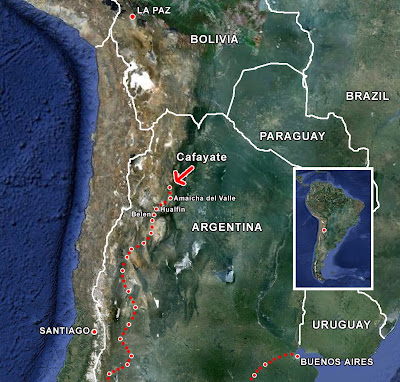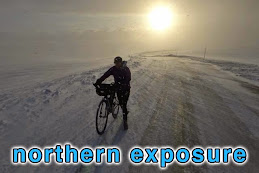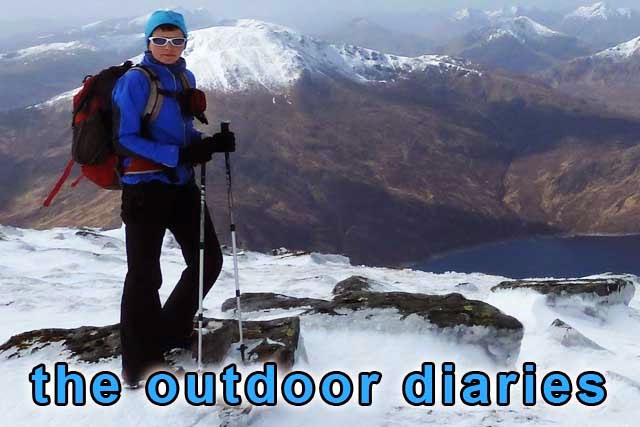 This blog comes to you from the dizzying altitude of 11,300 feet - I´m on the Altiplano at the border with Bolivia. It´s the end of the line for my cycle trip in Argentina - I can go no further north and in the next day or two I´ll cross into Bolivia.
This blog comes to you from the dizzying altitude of 11,300 feet - I´m on the Altiplano at the border with Bolivia. It´s the end of the line for my cycle trip in Argentina - I can go no further north and in the next day or two I´ll cross into Bolivia.It´s been an incredible journey through Argentina that´s captured the very essence of this whole trip - adventures, excitement and riding my bicycle through some of the most beautiful scenery on earth. But when I first set out from Buenos Aires I was full of fears and doubts about cycling here and when I returned to Argentina from Chile, I thought the challenges of the desert and the distances too great to tackle on my own. But I took on the challenges and Argentina has rewarded me with a pannier-load of memories to mull over in years to come.
I've seen so many beautiful places - Bariloche and the Lakes; the Tromen Pass and the monkey puzzle forests below Volcan Lanin; canyons of red rock; Butch Cassidy's cabin at Chollila; desert landscapes and oasis towns wrapped up in poplars; vineyards and orchards that stretch to the very foot of the mountains; the beautiful city of Salta; the cloudforest of La Cornisa. And yet Argentina had one more trick up her sleeve . . . the final road to Bolivia . . . the Quebrada de Humahuaca.
 The Quebrada de Humahuaca is a spectacular valley cut into the Andes that for centuries has linked the Altiplano with the plains below. It was first settled 10,000 years ago by the Omaguacas who gave it their name and today the population is still predominantly Indian. In 2003 it was designated a World Heritage site for landscape and culture. But before I tell you about my journey through the Quebrada, I should pick up my story back in Salta.
The Quebrada de Humahuaca is a spectacular valley cut into the Andes that for centuries has linked the Altiplano with the plains below. It was first settled 10,000 years ago by the Omaguacas who gave it their name and today the population is still predominantly Indian. In 2003 it was designated a World Heritage site for landscape and culture. But before I tell you about my journey through the Quebrada, I should pick up my story back in Salta.
I cycled north from Salta on a beautiful route known as "La Cornisa" which was quite unlike anything else I'd seen in Argentina. The road climbed high into a subtropical landscape of densely-forested mountains, all damp and drippy and draped with vines, ferns and lichens. It was like cloudforest or jungle, except cold. I wouldn't have blinked an eye if Tarzan had swung by on a vine shouting "Aaaaaaaaaaaaaargh ... it´s jolly chilly in this loincloth". Cycling and camping in a damp climate, just like the desert, presents life-threatening challenges. For example, a week of wet weather made doing laundry impossible and (readers of a sensitive disposition should look away now) I had to recycle pants and socks from the dirty laundry bag. Things don´t get much tougher than this!
North of La Cornisa I cycled over a 6500-foot pass back into a semi-arid landscape and the delightful village of Purmamarca, gateway to the Quebrada. It´s narrow streets of adobe buildings and colourful Indian craft market were overlooked by a spectacular rock face, the Cerro de Siete Colores - the Mountain of Seven Colours. It doesn't really need any further explanation! I'll fondly remember the campsite at Purmamarca. It was accessed by balancing along a plank across a fast-flowing, muddy river - a bit tricky with a bicycle! When heavy rain persisted into the evening, the owner came round to tell everyone that if we wanted groceries from the village we should go now as the river would likely rise and the plank would become inaccessible! At Purmamarca the road splits - it's a left turn for Chile and a right turn for Bolivia. I turned right and entered the Quebrada de Humahuaca.
After a few miles I pulled off the main road into the muddy streets of Maimara. There were two things I wanted to see here - the colourful rocks on the mountainside above the village known as La Paleta de Pintor (the Painter's Palette) and the little cemetery built on a hill. Beyond Maimara the valley was vibrant and green with little plots of maize, vegetabales and flowers where people worked along the rows in broad-brimmed hats. Between the plots were flat-roofed adobe houses and where the fields ended, the mountains rose sheer into a blue sky. It was absolutely idyllic. At least it was idyllic when the sun shone but, boy, did it rain a lot through the Quebrada and not just that gentle pitter-patter stuff either - it was torrential. An afternoon downpour in the village of Humahuaca turned the streets instantly into muddy torrents and cut me off from the campsite. I've been told that this year´s wet season is especially wet and especially long - oh lucky me! Despite the fresher climate I have to remind myself that I´m now in the Tropics - a few days ago I cycled across the Tropic of Capricorn or, as they call it in Argentina, the Tropico de Capricornio (true!).
 I loved cycling through the little towns that were dotted along the Quebrada - they had so much colour and life. This part of Argentina is more poor than the south so the towns do look a bit shabby but are likeable nonetheless. Narrow cobbled streets and colourful markets are wrapped around central plazas. And despite appearances, you still come upon modern internet kiosks and trendy cafes tucked away along the alleyways. In the evenings, tucked up in my tent, I would often hear bands marching through town playing jolly tunes on trumpets or more melancholy notes on pipes.
I loved cycling through the little towns that were dotted along the Quebrada - they had so much colour and life. This part of Argentina is more poor than the south so the towns do look a bit shabby but are likeable nonetheless. Narrow cobbled streets and colourful markets are wrapped around central plazas. And despite appearances, you still come upon modern internet kiosks and trendy cafes tucked away along the alleyways. In the evenings, tucked up in my tent, I would often hear bands marching through town playing jolly tunes on trumpets or more melancholy notes on pipes.
At the northerly limit of the Quebrada I cycled up to an amazing 12,400 feet and popped out onto the "puna", Argentina´s barren, high plains where llamas graze on sparse vegetation and exhibit an alarming tendency to wander onto the road in front of trucks. When the climbing got tough for me, I thought about the French family I'd spent some time with over the last week. Not only were Eric and Gaelle cycling with an amount of kit similar to mine, they were also towing two small children and everything that comes along with them - two trailers, clothes, toys and a potty!
A battle with the wind across the puna, brought me to La Quiaca, a lively border town. I´m relaxing here for a couple of days, taking time to say my farewells to a country I have so much fallen in love with. Argentina has gotten under my skin, she's coursed through my veins and settled in a very special place in my heart.
 Those of you that pay any attention whatsoever to this blog will recall that back in December in Argentina I cycled south from Bariloche in the footsteps of Butch Cassidy and the Sundance Kid to Cholila, to see Butch Cassidy´s cabin that still stands there and the ranch that the pair bought in 1905. You can read that blog again by clicking here. Back then, I wondered if I would pick up their trail again in Bolivia. Well, here I am in Tupiza, heart of Butch and Sundance country.
Those of you that pay any attention whatsoever to this blog will recall that back in December in Argentina I cycled south from Bariloche in the footsteps of Butch Cassidy and the Sundance Kid to Cholila, to see Butch Cassidy´s cabin that still stands there and the ranch that the pair bought in 1905. You can read that blog again by clicking here. Back then, I wondered if I would pick up their trail again in Bolivia. Well, here I am in Tupiza, heart of Butch and Sundance country. Tupiza is an attractive wee town, set in a natural amphitheatre on the banks of the Rio Tupiza and surrounded by mountains of red rock. When I pulled into town I was pretty exhausted but there was no chance to catch up on sleep next morning - each day at 5am the cathedral bells ring, a loud tannoy announcement welcomes the "brothers and sisters" to a new day and the little performance is rounded off with a rendition of Ave Maria! Tupiza is a vibrant and colourful place, especially at the central market where I like going shopping for groceries. Indian women in their colourful skirts and odd little bowler hats sell everything from fruit to fancy goods.
Tupiza is an attractive wee town, set in a natural amphitheatre on the banks of the Rio Tupiza and surrounded by mountains of red rock. When I pulled into town I was pretty exhausted but there was no chance to catch up on sleep next morning - each day at 5am the cathedral bells ring, a loud tannoy announcement welcomes the "brothers and sisters" to a new day and the little performance is rounded off with a rendition of Ave Maria! Tupiza is a vibrant and colourful place, especially at the central market where I like going shopping for groceries. Indian women in their colourful skirts and odd little bowler hats sell everything from fruit to fancy goods. But what I really wanted to see was on the hillside above the village - the tiny walled cemetery where the two outlaws are buried. I walked up the hill, catching my breath a little in the thin air, opened the iron gates and picked my way through a tight jumble of graves adorned with plastic flowers, fluttering in the breeze. In the middle, looking out over the mountains, was the last resting place of Butch Cassidy and the Sundance Kid. I felt a little emotional standing by the grave. I think that partly it was the culmination of my long journey here from Cholila and partly a similar experience to that at the cabin at Cholila - here was another very special piece of history in this remote little cemetery with the beauty and the power of the mountains all around. I lingered a while, took some photos, then wandered back down the hill, closing the gates behind me.
But what I really wanted to see was on the hillside above the village - the tiny walled cemetery where the two outlaws are buried. I walked up the hill, catching my breath a little in the thin air, opened the iron gates and picked my way through a tight jumble of graves adorned with plastic flowers, fluttering in the breeze. In the middle, looking out over the mountains, was the last resting place of Butch Cassidy and the Sundance Kid. I felt a little emotional standing by the grave. I think that partly it was the culmination of my long journey here from Cholila and partly a similar experience to that at the cabin at Cholila - here was another very special piece of history in this remote little cemetery with the beauty and the power of the mountains all around. I lingered a while, took some photos, then wandered back down the hill, closing the gates behind me.













